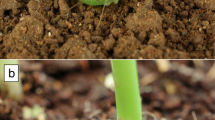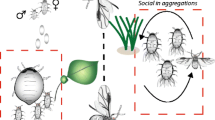Summary
Aggregation, shown by both nymphal and adult lime aphids, is not due to mutual tendency to select particular feeding sites, but is due to social aggregation, the aphids themselves being the attractive stimulus. In adults aggregation comes about through responses to visual stimuli from the wing patterns of other adults. Antennal contact between adults does not appear to be important in inducing settling, indicating that possibly visual or olfactory stimuli may be involved. With increased density closer spacing takes place resulting in increased antennal contact between adults and the possible significance of this is discussed. Closer spacing is not simply a result of limited space available at high densities but is self imposed by the adults themselves.
Similar content being viewed by others
References
Bell, W.J., Parsons, C., Martinko, E.A.: Cockroach aggregation pheromones: Analysis of aggregation tendency and species specificity (Orthoptera: Blattidae). J. Kansas entomol. Soc. 45, 414–421 (1972)
Campbell, D.J., Clarke, D.J.: Nearest neighbour tests of significance for non-randomness in the spacial distribution of singing crickets (Telogryllus commodus (Walker)). Anim. Behav. 19, 750–756 (1971)
Clark, P.J., Evans, F.C.: Distance to nearest neighbour as a measure of spacial relationships in populations. Ecology 35, 445–453 (1954)
Dahl, M.L.: Über einen Schreckstoff bei Aphiden. Dtch. entomol. Z. 18, 121–128 (1971)
Dixon, A.F.G.: Population dynamics of the sycamore aphid, Drepanosiphum platanoides (Schr.) (Hemiptera: Aphididae). Migratory and trivial flight activity. J. anim. Ecol. 38, 585–606 (1969)
Dixon, A.F.G.: Quality and availability of food for a sycamore aphid population. In: Animal populations in relation to their food resources (A. Watson, ed.), pp. 271–287. Oxford: Blackwell 1970
Dixon, A.F.G., Wratten, S.D.: Laboratory studies on aggregation, size and fecundity in the black bean aphid, Aphis fabae (Scop.). Bull. ent. Res. 61, 97–111 (1971)
Dixon, A.F.G., Logan, M.: Population density and spacing in the sycamore aphid, Drepanosiphum platanoides (Schr.) and its relevance to population growth. J. anim. Ecol. 41, 751–759 (1972)
Ellis, P.E.: Social aggregation and gregarious behaviour in hoppers of Locusta migratoria migratorioides (R&F.) Behaviour 5, 225–227 (1953)
Ellis, P.E.: Differences in social aggregation in 2 species of locust. Nature (Lond.) 178, 1007 (1956)
Ellis, P.E.: Some factors influencing phase characters in nymphs of the locust Locusta migratoria migratorioides (R. & F.). Insectes Sociaux 6, 21–39 (1959)
Gillett, S.: Airborne factor affecting the grouping behaviour of locusts. Nature (Lond.) 218, 782–783 (1968)
Ibbotson, A., Kennedy, J.S.: Aggregation in Aphis fabae (Scop.). 1. Aggregation on plants. Ann. appl. Biol. 38, 65–78 (1951)
Keenleyside, M.A.: Some aspects of the schooling behaviour of fish. Behaviour 8, 183–248 (1955)
Kennedy, J.S., Crawley, L.: Spaced-out gregariousness in the sycamore aphid (Drepanosiphum platanoides). J. anim. Ecol. 36, 147–170 (1967)
Kidd, N.A.C.: Aggregation in the lime aphid (Eucallipterus tiliae L.). 1. Leaf vein selection and its effect on distribution on the leaf. Oecologia (Berl.) 22, 299–304 (1976)
Kislow, C.J., Edwards, L.J.: Repellent odours in aphids. Nature (Lond.) 235, 108–109 (1972)
Lees, A.D.: The production of the apterous and alate forms in the aphid, Megoura viciae (Buckt.), with special reference to the role of crowding. J. Insect Physiol. 13, 289–318 (1966)
Marsh, D.: Sex pheromone in the aphid Megoura viciae. Nature (Lond.) (New Biol.) 238, 79, 31–32 (1972)
Marsh, D.: Responses of the aphids to the female sex pheromone in Megoura viciae Buckton. J. Ent. (A) 50 (1), 43–64 (1975)
Nault, L.R., Edwards, L.J., Styer, W.E.: Aphid alarm pheromones: Secretion and reception. Environ. Entomol. 2, 101–105 (1973)
Nolte, D.J., Eggers, S.H., May, I.R.: A locust pheromone: locustol. J. Insect Physiol. 19, 1547–1554 (1973)
Pettersson, J.: An aphid sex attractant. I. Biological studies. Entomol. Scand. 1, 63–73 (1970)
Roth, L.M., Willis, E.R.: The biotic associations of cockroaches. Smithsonian Misc. Coll. 141, 1–470 (1960)
Tamaki, G., Butt, B.A., Landis, B.J.: Arrest and aggregation of male Myzus persicae. Ann. Entomol. Soc. Amer. 63, 955–960 (1970)
Way, M.J., Banks, C.J.: Intra-specific mechanisms in relation to the natural regulation of numbers of Aphis fabae (Scop.). Ann. appl. Biol. 59, 189–205 (1967)
Way, M.J., Cammell, M.: Aggregation behaviour in relation to food utilisation by aphids. In: Animal populations in relation to their food resources (A. Watson, ed.), pp. 229–247. Oxford: Blackwell 1970
Wientjens, W.H.J.M., Lakwijk, A.C., van der Marel, T.: Alarm pheromone of grain aphids. Experientia (Basel) 29, 658–660 (1973)
Author information
Authors and Affiliations
Rights and permissions
About this article
Cite this article
Kidd, N.A.C. Aggregation in the lime aphid (Eucallipterus tiliae L.). Oecologia 25, 175–185 (1976). https://doi.org/10.1007/BF00368852
Received:
Issue Date:
DOI: https://doi.org/10.1007/BF00368852




